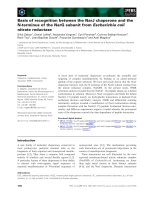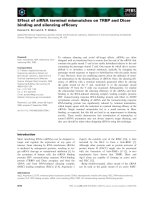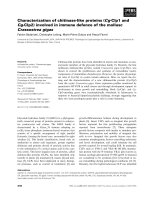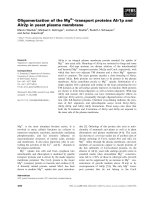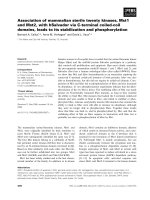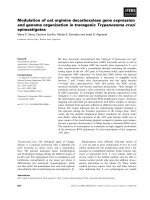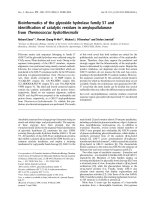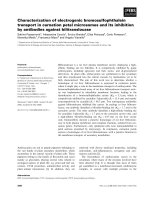Báo cáo khoa học: "Changing of Women’s Roles in Agricultural and Handicraft Production: A Case Study in Kim Thieu Village, Tu Son District, Bac Ninh Province" pdf
Bạn đang xem bản rút gọn của tài liệu. Xem và tải ngay bản đầy đủ của tài liệu tại đây (183.91 KB, 11 trang )
Journal of Science and Development April 2008: 49-59 HANOI UNIVERSITY OF AGRICULTURE
Changing of Women’s Roles in Agricultural and Handicraft Production:
A Case Study in Kim Thieu Village, Tu Son District,
Bac Ninh Province
Nguyen Phuong Le
*
*
Faculty of Economics and Rural Development, Hanoi University of Agriculture
Abstract
Vietnamese women have been playing a key role in economic development for a long time.
Due to social and cultural constraints, rural women were excluded from some kinds of work,
especially those which consist of cultural meanings, for instance, the art woodcarving industry.
Under the changes of economic and social conditions, women are increasingly participating in
traditional occupations. Further, by negotiating with the patriarchal idea of gender discrimination
of work, women can take part in traditional woodcarving activity not only as direct workers, but
also as business owners, entrepreneurs and managers. However, the empirical data from Kim
Thieu village demonstrate that rural women remain subordinated to male authority in the family
and community. Thus, gender policies which pay attention to both economic and social
empowerment of women are necessary in the context of a patriarchal society like Vietnam.
Keywords: Rural women, gender division of labor, household livelihood strategies,
negotiation, empowerment.
1. INTRODUCTION
Vietnam's rural women account for more
than a half of the country's overall population,
52 percent of its labor force and 70 percent of
rural labor force (Nguyen Linh Khieu, 2003).
Vietnamese women have played a key role in
economic development since the Feudal period.
They have established an important force in
creating physical products and building rural
socio-culture. Women have contributed to both
economic and non-economic sectors in rural
areas. They have produced almost 60 percent of
GDP of rural economy (Nguyen Linh Khieu,
2003).
Due to the social and cultural constraints,
Vietnamese women could not participate in all
economic activities in the past. They mostly
worked as farmers in agricultural and small
trade activities, while the so-called industrial
work have been assigned to male laborers.
Woodcarving industry in Kim Thieu village
was one of several sectors from which rural
women were excluded. However, thanks to the
reform of the state’s economic policy, rural
women are able to take part in almost all sectors
of rural economy such as agriculture, industry,
handicraft making and product marketing.
Together with the change of economic policy,
high demand for labor for industrialization and
commercialization of rural economy has
allowed not only men, but also women to seek
their jobs in both agricultural and non-
agricultural sectors. Further, as active agents of
development, rural women themselves have
found the ways in which they can participate in
and conduct different economic activities. By
doing this, women are not only emancipated
from male economic dependence, but they also
empower themselves at a household as well as a
community level.
49
Nguyen Phuong Le
As a small contribution to the debates of
women’s contribution to household economy,
the objectives of this paper are: (i) to show how
gender divisions of labor change according to
historical context in a traditional craft village in
Northern Vietnam; and (ii) to explore the ways
in which women negotiate for diversification of
households’ livelihood strategies.
2. METHODS
Methodology
The ethnographic approach has been used
in collecting both secondary and primary data.
This means that the researcher might have a
long stay in the field site. Additionally, the
researcher had to join the so-called “everyday
life” of local people in order to find the way in
which gender division of rural labors in
production has been arranged and the reasons
for which women as well as men have been
assigned to different economic activities in the
past and present. A number of PRA
(Participatory Rural Appraisal) techniques such
as group meeting, participatory observation and
oral history recording have been employed to
get information from different villagers.
Together with PRA techniques, the in-depth
interview method was also applied to gather
data from 20 typical households. Moreover, key
informants such as head of the communal
women’s union, headman of the village, some
young and senior women and men were
selected as interviewees.
Information and data which were collected
focused on the ways in which gender division
of labor were carried out in the households as
well as in the workplace. Further, individual
stories concentrated on the ways in which
village women negotiated for their entrance to
the “traditional occupation”. All the data are
analyzed by the qualitative methods which are
mainly based on the typical stories of villagers
rather than on the general information.
Additionally, the SWOT (Strengths-
Weaknesses-Opportunities-Threats) analysis
matrix is applied to scrutinize the advantages
and disadvantages of village women when
they participate in the diverse economic
activities. Based on the result of analysis, the
major policy implications will be
recommended to empower women as well as
to reduce gender inequality in the village.
Overview of the Research Site
Located in the Red River delta, 30 km
from Hanoi, Kim Thieu is one of six villages
in the Huong Mac commune, Tu Son district,
Bac Ninh province. Like other villages in the
region, Kim Thieu is considered a traditional
craft village with an age-old history. In 2005,
Kim Thieu had 1682 inhabitants who lived in
320 households, of which 264 households
operated craft activities. Apart from the
woodcarving industry, Kim Thieu villagers
still cultivate agricultural land which they
were allocated by the state since 1988. Total
cultivated area of the village is 36.72 hectares
(102 mau), so the agricultural land area per
capita is about 200m
2
which is considered as
the lowest in the region.
Table 1. Classification of households by their
livelihood strategies.
Categories of households Percent
1. Craft making only (loaned farmland to
other villagers)
30
2. Craft making and rice cultivation in
allocated land only
40
3. Craft making and rice cultivation in both
allocated and borrowed land
30
Total 100
Source: Statistic Section of Commune, 2005.
The prevailing crop-pattern is double rice
per year. It can be said that the livelihoods of
villagers here are to combine a number of
activities together, but mainly based on farming
and craft making. However, agricultural
50
Changing of Women’s Roles in Agricultural and Handicraft Production:
production at present is mostly conducted by
hired labors from outside.
Nobody can know when the woodcarving
industry appeared in Kim Thieu village, but
since the period of domination by northern
invaders, there were some villagers
accompanying thousands of wood carvers who
had to go to China to work as slaves. There
was a hypothesis which supposed that wood
carving might be present in Kim Thieu as well
as the areas surrounding it due to the
appearance of the Thang Long capital under
the Ly dynasty (eleventh century). In the
feudal period Kim Thieu wood carvers used to
provide labor for construction of temple,
communal house, pagoda, and the imperial
palace. In addition, they were required to
decorate for the royal and the rich people’s
houses. During the Le dynasty (from 15
th
century to 17
th
century), with the establishment
of 36 Hanoi guilds (phường), Kim Thieu
craftsmen not only supplied carving services,
but also produced handicrafts for sale. This
was also the time appeared many professional
organizations especially the craft guild as well
as trade villages. The guild of Kim Thieu
woodcarvers comprised all artisans in the
village. The guilds were gendered according to
the products, for example, the guild of
carpenters never consisted of female members,
whereas the guild of weavers rarely comprised
male members. However, due to the changes
of social and economic conditions, village
women have increasingly engaged in the
woodcarving industry in different ways with
different roles.
3. CHANGING WOMEN’S ROLES IN
PRODUCTION IN KIM THIEU VILLAGE
As mentioned previously, women have not
been allowed to formally participate in
traditional handicraft production since the early
days. Traditionally, rural women were assigned
to kinds of work which were considered as
relevant to their “biological” characteristics. For
this reason, rural women often worked on
agriculture, small trade and weaving with very
limited mobility. However, women’s
occupation, as well as their spatial mobility has
remarkably changed in historical context. In
this paper, the changes in women’s roles in
production will be analyzed in three major
periods of economic development in Northern
Vietnam, which are pre-collectivization,
collectivization and economic liberalization.
Women’s Roles in Production in Pre-
Collectivization Time
In the time of pre-collectivization, villagers
lived mainly by farming, animal rearing and
partly on woodcarving activities. The reason
was the fact that rice cultivation alone was not
able to make a village a complete economic cell
(Tung, 1993). As mentioned in a variety of oral
histories, there was no clear gender division of
labor in farming. Men and women worked
together in their own small plots or they worked
as tenants for landlords in the village. However,
gender division of labor in farming at that time
reflected the physical and psychological
qualities attributed to respective sexes - the
strength of men, and the dexterity and patience
of women (Elson, 1997). Based on this sexual
differentiation, different tasks were assigned to
men or to women. In general, those tasks
requiring great strength and energy such as
plowing and irrigating fell to men, whereas
women were responsible for work that was
more onerous and time devouring such as
transplanting, weeding and harvesting.
Although animal rearing and gardening could
be seen as important secondary sources of
households, both of these activities were
assigned to different generations of female
members such as grandmother, mother and
oldest daughter. As in other regions, Kim Thieu
villagers have considered animal feeding and
51
Nguyen Phuong Le
gardening as female sectors because they were
conducted in a domestic sphere.
Similar to other villages in Red River delta,
handicrafts provided villagers with a
particularly significant source of subsidiary
income, especially in the case of starvation
(Scott, 1976). However, craft making activities
were merely considered as “supported activities
for household economy” in this period. The
peasants reserved only their leisure time for
craft works, doing them after finishing their
farm work in the fields. The oral histories of
Kim Thieu village indicate that most of the
artisans who had to go to work outside the
village were no-land or landless peasants. This
means that many peasants were forced to
become artisans because of their subsistence
security. Moreover, in this period, woodcarving
services used to be paid in-kind, frequently by
rice or paddy. The amount of rice or paddy
which was received by wood carvers merely
met their own needs and a small surplus for
their families. For this reason, the value of craft
work was perceived as equal to farming work.
According to the rungs of Confucian
ideological framework (1.scholar, literati;
2.peasant; 3.artisan; 4. merchant), craft work
was at the lower position in comparison with
farming work (Luong, 1997).
Although woodcarving was seen as an
equal or lower position with farm work in terms
of economic gain, it was more privileged in
cultural aspect because of patriarchal social
constraints and differentiations not only
between men and women, but also between
insiders and outsiders. Before the colonial
period, woodcarving was bound within the
village. It has never been taught to outsiders,
even to the daughters who were born in the
village. Besides, village customs did not allow
matrilocal practice. All these local laws were
maintained in order to withold special skills of
craft production from the outsiders.
Both old female and male interviewees
contended that in the Feudal period, only men
could participate in the craft work because of
two reasons. Firstly, the craft work was related
to construction of temple, pagoda, communal
house, imperial palace and making a roof,
where women had been excluded from due to
the gender ideology of spirituality. Secondly,
provision of woodcarving services and selling
of products in Hanoi city needed the labor’s
mobility which was one of the major constraints
for women in a patriarchal society. Both
spiritual and mobile restrictions prohibited
women from involvement in traditional wood
carving activities.
Wherever you (male carvers) go to work,
I (carvers’ wives) will carry chisels and planes and
go with you.
(Local Idiom)
This gender ideology of work was
contested. Although women were not able to
engage in woodcarving the same way as men,
they could take part in it by their traditional
roles in the family. Female villagers used to
travel with their husbands in order to not only
look after their husbands, but also the team of
carvers with: food provision, washing, and
doing some minor work as active helpers, as
demonstrated in the popular local idiom.
In the Feudal period, woodcarvers in Kim
Thieu village were called “artisans” with a more
or less respectable attitude. The reason is the fact
that there were very few artisans in general;
woodcarvers in particular at that time. The
know-how of woodcarving was strictly kept
within each village. As a result, it was
impossible to deliver to everyone. The craft
products served wealthy people who were
privileged in society. In addition, these products
were produced for special purposes such as
religion: mostly Buddhism, and national
symbols. For these reasons, craft making
52
Changing of Women’s Roles in Agricultural and Handicraft Production:
activities mostly belonged to men, not to women.
Patriarchal customs coupled with Buddhist
ideology of gender excluded women from craft
activities. The term artisans had only referred to
men, and implicated male superiority.
Gender Division of Labor in Production in
the Collectivization Period
At the end of the 1950s, the Vietnamese
government implemented economic reform on
agricultural and rural economy. The main content
of this reform was to collectivize all means of
production. By doing this, all households in the
village were gathered in the agricultural
cooperative. Similarly, village craftsmen were
organized in a handicraft cooperative. The
cooperative regime has significantly contributed
to the equalization of male-female relations by
transforming wives, unmarried daughters and
daughters-in-law from unpaid family labor to
cooperative paid members. This way of women’s
liberalization had been carried out not only in
agriculture but also in other sectors including rural
industry, craft making, and rural trade. In other
words, in the time of collectivization, women’s
work was remunerated by the same system as the
men in their family.
Immediately after its establishment, the
Handicraft Cooperative’s Management
Committee in Kim Thieu village invited
lecturers from Hanoi University of Fine Art
going to teach fundamental theory of
woodcarving for its members including both
men and women.
However, female workers were only
allowed to carry out the simple work.
Particularly, during the late 1960s and the early
1970s, the Handicraft Cooperative seemed to
stop carving wood but changed to carve ivory
based on the contracts between the Central Art
Import-Export Company with Indian
Companies. Women could not engage in such
activity because it was so difficult that only
high-skilled male carvers could do it. In the late
1970s, due to the withdrawal of Indian
Companies, the Handicraft Cooperative
changed to sculpt statues and to carve wooden
pictures in order to export to Eastern European
countries. Unlike ivory carving, female workers
could participate in carving of wooden statues
and pictures. They could complete these
products by themselves. However, female
cooperative members were fewer than male in
both absolute number and proportion.
Moreover, the Handicraft Cooperative
employed the industrial model to its productive
process. This meant that production processes
were specialized by stages. In woodcarving,
male carvers were responsible for the main and
more important stages such as framing or basic
carving while female carvers only completed or
made the products better.
It can be said that it is the first time we (female
villagers) had been taught how to carve, and since
that time we could join formally in traditional craft
work.
(A village woman - April, 2006)
In short, there were a lot of changes in craft
making activity during collectivization in
comparison with the previous period. One of
the most important changes is that the skills of
craft making were no longer kept secret within
small group of male carvers. All men and
women in the village, even outsiders, were able
to access to the so-called “know-how” of wood
carving because these skills were taught as
other scientific knowledge by modern methods.
As a consequence, artisans’ position was no
longer important as before, and the meaning of
craft work also changed. The most significant
change was the fact that craft work was not a
male- dominated occupation any more, but
women were able to participate.
In spite of that, women’s liberalization and
gender equality in the period of collectivization
in Vietnam could be seen as a “myth” for of the
following reasons. Firstly, though women can
53
Nguyen Phuong Le
go and work in the same unit with men, they are
usually in the lower rank of work in comparison
with men due to their lack of education, skill,
and productivity. For example, in the
agricultural cooperative men mostly occupied
the work that needed great strength and energy
like plowing and pesticide spreading, so they
used to receive higher work-points than what
women received. Thus, they had more power
and control over the distributed produce at
family level.
Before doi moi, even in the collectivized period,
no-one observed any women who were able to
carve sophisticated wooden pictures. But
nowadays, they not only can carve, but also
design subtle wooden art. Some of the village
women became very successful in the
woodcarving business. Their families have big
factories and they have contracted with several
other factories in Kim Thieu and in surrounding
villages. All woodcarvings produced by these
factories will be exported to China. These persons
have good relationships with many large
customers in big cities in China such as Beijing,
Shanghai, Hangzhou, Xian, Guangzhou, Fukien,
Shangdong, and Shengzhen, so that they can sell
a lot of woodcarvings. The monthly revenue of
their business is about a billion VND (more than
sixty thousands USD). These women usually go
back and forth from the village to the border
market (Fouzhai market - 150 km far from the
village) five or seven times a month because they
have rented showrooms there.
(Nguyen Van San - A statistical staff in commune,
October 2006)
Similarly, in the handicraft cooperative,
men received higher salary than women
because they did the skilled work while
women were assigned to unskilled work.
Secondly, there were less women able to
reach the leading position as men were in the
productive organizations such as cooperatives
and factories. Lastly, women could go and
work in the same unit and do the same work
as men in the workplace, but they had to
spend the same time for domestic work
including cultivating in private plots and
home gardens and keeping animals as before.
The fact is that even if women can go to the
workplace like men, they continue “to be
subordinated, but in the new form of
socialistic patriarchal family, socialist
working conditions, far from having liberated
women, doubly burdened them” due to
patriarchal customs (Rofel, 1999).
Changing Women’s Roles in Production in
the Period of Economic Liberation
A Big Change of Women’s Roles in the
Woodcarving Industry
Since the initiation of de-collectivization of
both agricultural and handicraft cooperatives in
the late 1980s and its more recent acceleration by
new land reforms, agriculture and rural
livelihoods in Vietnam have experienced a great
transition (Tuan, 1995). The peasant household
economy has become the most important mode
of production. In the period of economic
liberalization, peasant livelihoods in Kim Thieu
village are no longer dependent on rice
cultivation, but on a number of income-
generating activities both on-farm and off-farm.
Change in peasant livelihoods has brought about
change in gender relations in production. Due to
the expansion of production with a high demand
for labor, most of male and female villagers
engage in craft work.
The roles of female labor in craft work
now are more diverse than before. Women
who were born in the village can take part in
stages which they had been excluded from
because of traditional patriarchal customs and
gender discrimination. Village women are
involved in craft work in various ways. If they
are village women, they either directly
participate in woodcarving or are responsible
for marketing products. If they are hired
laborers, they are mostly assigned to simple
tasks such as polishing and cleaning products
before selling.
54
Changing of Women’s Roles in Agricultural and Handicraft Production:
Livelihood Diversification: Double-burden or
Empowerment?
The reality of craft village development
witnesses the fact that livelihood diversification
forces women in most craft villages in Northern
Vietnam to experience the triple-burden of on-
farm, off-farm and domestic work because
these village women don’t want entirely to give
up farming for off-farm jobs. The question is
why village women keep farming even if their
household income is mostly generated from the
craft making industry.
A variety of agrarian studies interpreted
that villagers try to keep farming even if they
can get high income from off-farm sources
because of their subsistence security in the
context of economic vulnerability. However,
from the view point of gender research, it
could be contended that farming, especially
rice cultivation, in an off-farm-based
community helps women empower
themselves for several reasons. Firstly,
women’s income sources become more
diverse than men’s. While village men only
generate income from woodcarving, women
can contribute to the family budget not only
by off-farm, but also by on-farm incomes
which, for Beneria (1997), will be very
critical in the context of economic crisis when
stagnation happens in the woodcarving
industry. Secondly, by keeping farming as a
strategy in livelihood diversification, women
provide not only rice, but also vegetables and
other foodstuffs for their family members
including men, and not only for themselves
(Schroeder, 1999). Further, in the time when
chemical inputs are overwhelmingly used,
providing their family with organic and fresh
farm produces makes women become even
more powerful. Thirdly, by leasing their farm
work out to others, women not only avoid the
double-burden, but they also create
themselves a new kind of power. The Kim
Thieu woodcarving village witnessed the rise
of hierarchical relationships among women -
one whose livelihood is based on off-farm
activities and the other whose livelihood is
agriculture-based. The discrimination is
expressed not only between the female
owners and female workers, but also between
other villagers and hired laborers. Some
village women, even though they have never
hired laborers, still consider female hired
laborers as subordinate to them.
It can be argued that women have the
capability to turn rice farming from a
subsistence, female-dominated, and less
privileged sector into new kinds of power at
both intra- and extra-household levels.
How Can Village Women Diversify Their
Livelihood Strategies?
A proliferation of livelihood studies
showed that when rural livelihoods become
more diverse, there are three trends of gender
arrangement of labor in rural households. The
first trend asserts that women have been left
with farming tasks and numerous chores, while
male members go to seek outside work. The
second popular trend of labor arrangement
refers to the double-burden or multiple-burden
of rural women when they have chance to
diversify their livelihood strategies. The last
trend seems to be more romantic when
discussing the flexibility and change of gender
roles in both productive and reproductive
spheres. All of these trends are not relevant to
the ways in which village women negotiate for
diverse livelihood strategies in Kim Thieu
village.
Unlike the popular trends of labor
rearrangement mentioned above, high income
from the woodcarving industry allows village
women to hire laborers, mostly women, from
the agriculture-based community for rice
cultivation. By doing so, they can both
participate in woodcarving as direct workers
55
Nguyen Phuong Le
and conduct farming as managerial staff. A
number of women, especially young women,
assert that they can keep farming as a strategy
of their diverse livelihoods, but they do not
need to do it by themselves.
Now you cannot see any village women directly
working in the rice field because earning from
woodcarving is much higher than what you need to
pay for hired labor. If I spend one day on
woodcarving, I can pay for two or three man-days of
farm work. Moreover, woodcarving can be carried
out at home while farm work has to be done outside
in the dirt. For this reason, I usually give my mother
money to hire labor in the peak-seasons such as
transplanting and harvesting, instead of doing by
myself. It is very easy to look for female laborers
willing to work in others’ plots in our region.
(Tran Thi Tuyet, twenty-one-year-old girl,
October 2006)
The question here is why market of hire
labor becomes available in rural area.
Like other regions in Southeast Asia, the
introduction of numerous technical
innovations in agricultural production caused
the reduction of the amount of labor per land
unit. As a result, women in farm-based
communities can finish their farm work faster
and they have more time to work outside as
hired or contract laborers. The motivation of
livelihood diversification of farm-based
women can be seen as an element that helps
women in woodcarving village realize their
diverse livelihood strategies. Together with the
availability of hired labor and the introduction
of technological innovations, rural women
succeed in negotiation for their livelihood, and
empowerment, thanks to the combination
between their own exertion and outside
support from public agencies and development
programs, such as education, infrastructure,
and so on. Apart from farming and
woodcarving, some village women perform
different income-generating activities. These
active women do many types of business such
as: slaughtering pigs and selling pork,
operating a grocery, and trading fruits in the
local market.
I usually get up at four AM, and go to slaughter a
pig with some villagers as my colleagues. We
slaughter one pig a day, then divide it into three
parts for three retailers. I start to sell pork at seven
AM in the local market because I am one of
retailers. I often finish my business at nine or ten
o’clock. I come home to prepare lunch for my
family and two hired permanent laborers. In the
afternoon, I spend time on farming activities,
polishing things, or participating in some activities
of the Women’s Union.
(Nguyen Thi Toan, October 2006)
The question is how village women like
Mrs. Toan can operate very complicated
livelihood strategies as described and maintain
responsibility to almost all domestic tasks.
According to Mrs. Toan and Mrs. Hoa, they
don’t have to do all the work by themselves.
They can ask the help from other family
members. In the case of Mrs. Toan, she has two
single daughters who work as craftswomen at
home. When she comes home late, her
daughters stop working earlier for cooking and
feeding the pigs. Further, with the help of
modern facilities such as an electric rice cooker
and other machines, chores are no longer work
loads for women. Like Mrs. Toan, Mrs. Hoa
can get the help from her husband and her
mother-in-law when she went to China for her
business. She usually makes prior appointments
with Chinese customers, so she merely spends
two or three days for one journey from her
home town to the border market. Besides, the
support of modern means of communication
and transportation allows her to contact her
customers more easily and she doesn't need to
take so much time.
Although village women increasingly
participate in different economic activities and
play more important roles in household economy,
they are still main in domestic workers. They
remain, faced with patriarchal constraints in
everyday life, especially at the communal level.
56
Changing of Women’s Roles in Agricultural and Handicraft Production:
The traditional customs of a patriarchal society
seems to be a barrier which limits rural women to
take part in social and cultural activities in their
community. Mrs. Thich - a fifty-four-year-old
woman recalls that:
On the day of a village festival, my husband
invited his friends to have lunch in my house. I
had prepared food for them before I went to join a
music performance of village women because I
was one of the best folk singers. But, do you know
what happened when I came back from the
performance? I was shocked when I saw all the
plates and bowls were cast down on the yard in
front of my house. Further more, my husband
angrily shouted at me, “who allowes you to be
absent when we had lunch”? Did he mean that I
had to stay at home to serve them as a maid? I
was very sad but I kept quiet. I was afraid that if I
said something against him, I wouldn’t have a
chance to go out for such activities.
(November, 2006)
In summary, in the modern time, village
women not only have more job opportunities,
but they also know how to improvise different
factors and social relations in order to
negotiate their livelihoods. Moreover, in the
process of negotiation for livelihoods, village
women can obtain two purposes, which are to
improve the living-standard of their families
and them and to empower themselves in the
household and community levels. However, it
can be argued that village women still accept
patriarchal differentiation of gendered roles
within the family. Most of them adopt the
traditional norms because they don’t want to
trade off their total freedom by losing their
stable intrafamilial relationships.
The Opportunities and Challenges for Rural
Women in Economic Development
In this section, the SWOT analysis matrix
is applied to indicate the strengths,
weaknesses, opportunities and threats of rural
women when they increasingly participate as a
major labor force in a number of economic
activities. As an outcome from the PRA
approach, the SWOT matrix here was built
based on the interviews of key informants and
group meetings of village women.
Table 2. SWOT Analysis Matrix of Rural Women’s Participation in Production
Strengths Weaknesses
- Women can access the traditional woodcarving industry
because they were born in the village
- Some women were trained the skills of woodcarving since
the early days of collectivization; Most of the female artisans
have been trained by transferring traditional skills from
generation to generation
- Village women possess “nimble fingers”, patent and
patient characteristics
- Small credit fund targeting rural women for household
economic development
- Strong capacity of the local women’s union in supporting
its members in economic development
- Woodcarving industry - the high return economic activity is
still considered a “male sphere”
- Women are seen as main doers of farm sector and
domestic chores
- Patriarchal and Confucian ideas of gender differentiation
prevent village women from political, social and cultural
activities
- Traditional perception of gender division of labor more or
less devalues women’s contribution to the household
economy
- Many women tend to accept the traditional norms and
customs which confine women to a reproductive sphere,
especially the idea of “son preference”
5- High demand for woodcarving products by domestic
and international consumers creates employment
opportunities for village women
- Availability of hired labor in the local market, modern
agricultural technologies and domestic facilities help women
to avoid double-burden
- Availability of policy on gender equity in the country as well
as in the region
- Instability of global market for woodcarvings affects
women’s economic contribution
- Low educational levels among women
- Women have to cope with health problem caused by
pollution in both woodcarving and agricultural production
- Lack of a general project integrating rural women into
economic development
57
Nguyen Phuong Le
Based on the result of SWOT analysis, the
major recommendations for policy-makers on
women’s empowerment and gender equity are
drawn as following:
First, although the Vietnamese government
have promulgated a number of policies and
programs aiming at improving women’s roles
in household economic development, these
programs mostly targeted those who live in the
remote areas while they seemed to neglect
women who live and work in peri-urban places.
As a result, women in Kim Thieu village have
rarely benefited from development projects,
though they need the knowledge of doing
business in the context of commercialization
and global economic integration. Most female
traders there do business either based on their
own experience or by learning from their
relatives. Thus, providing women in peri-urban
area like Kim Thieu village with business
knowledge should focus in national economic
policy.
Secondly, as pointed out by other
researchers on gender issues, the growing
participation of women in paid employment has
contributed significantly to the economic and
social empowerment of women. Access to
earned income improves women's position
within the household substantially, giving them
greater control over the distribution of such
earnings and household resources, and
generally improving their status and strength in
society, as well as their own self-esteem.
However, this line of argument seems to ignore
the intrafamilial power relations in patriarchal
society. The empirical data in Kim Thieu
village has demonstrated that even if women
significantly contribute to the household
budget, they are still subordinated to male
authority in other aspects. For this reason, apart
from the measures to give women employment
opportunities, government agencies should pay
more attention to social aspects in making
policies on gender equity.
Thirdly, while a growing number of
women succeeding in the use of new and
innovative technologies in the industrial sector,
women who work in the family-based sector
remain trapped into simple, traditional and
manual techniques. For this reason, pollution
from those technologies negatively can impact
the health of female workers. Supplying women
with the knowledge of protection from noise
and dust should be an important part of the
revival and development strategy of traditional
craft village in the Red River delta.
Lastly, aside from providing women with
training courses on innovative technologies and
business skills, government and non-
government organizations should help rural
women to actively perceive their important
roles and positions in both production and
reproduction. By doing this, rural women can
empower themselves and they will become
more self-confident to participate in different
economic as well as social activities.
4. CONCLUSION
Women’s work and values of their work
should be perceived and assessed in a specific
context. The case study in a traditional craft
village indicates that patriarchal ideology of
gender in work differentiation can be changed
accordingly to the variation of economic, social
and political conditions. The data and
information demonstrate that the clear
discrimination of work can be seen in the pre-
modern time and even in the communist regime
under the structure of cooperatives. But in the
period of economic liberalization, gender
relations in both the farming and the craft
making industry have changed a lot. Women
are no longer confined in the traditional
occupations, but they have occupied many
kinds of work that used to belong to men.
Change of gendered patterns of work brings
about the change in gender relations not only in
58
Changing of Women’s Roles in Agricultural and Handicraft Production:
production, but also in other aspects. By
responding to domestic work and to a number
of income-generating activities, women have
more voice in their families as well as in the
community.
It can be argued that the patriarchal
ideology of work and the patriarchal gender
division of labor are not big fixed structures,
but they can be modified in particular
situations. Therefore, the patriarchal customs
and norms are being deconstructed and
reconstructed in a specific context. In the case
of Kim Thieu village, women have been
negotiating for changing their occupations as
well as their economic contributions to the
household. Nevertheless, at the end of the day,
they still adopt the traditional patriarchal
customs of gender differentiation as the
“identity” of village women.
5. REFERENCES
Beneria, Lourdes. (1997). “Accounting for
Women’s Work: The Progress of Two
Decades” in Visvanathan, Nalini et al
(eds) The Women, Gender and
Development Reader. London and New
Jersey: Zed Books
Elson, D. and Pearson, R. (1997). “The
Subordination of Women and the
Internationalization of Factory
Production” in Visvanathan, Nalini et al
(eds) The Women, Gender and
Development Reader. London and New
Jersey: Zed Books
Khieu, Nguyen Linh. (2003). A Study on
Woman, Gender and Family (Nghiên
Cứu Phụ Nữ, Giới và Gia Đình). Hanoi:
Social Scientific Public House
Luong, H. v. (1997). “Engendered
Entrepreneurship-Ideologies and
Political-Economic Transformation in a
Northern Vietnamese Center of Ceramics
Production”. In: R. W. Hefner (ed)
Market Cultures: Society and Morality in
the New Asian Capitalisms. Boulder-
San-Francisco-Oxford: Westview Press:
290-314.
Rofel, Lisa. 1999. Other Modernities: Gendered
Yearnings in China after Socialism.
Berkeley, Los Angeles, and London:
University of California Press.
Schroeder, Richard A. (1999). Shady Practices:
Agroforestry and Gender Politics in the
Gambia. Berkeley, Los Angeles, and
London: University of California Press.
Scott, J. C. (1976). The Moral Economy of the
Peasant: Rebellion and Subsistence in
Southeast Asia. New Haven and London:
Yale University Press.
Tuan, D. T. (1995). “The Peasant Household
Economy and Social Change”. In:
Benedict J. Tria Kerkvliet and Dong J.
Porter (eds) Vietnam's Rural
Transformation. Colorado: Westview
Press: 139-163.
Tung, N. K and Dinh, B. X. (1993). “Sideline
Occupation of Peasant Households in
Vietnam”. In: Phan Huy Le et al (eds)
The Traditional Village in Vietnam.
Hanoi: The Gioi Publishers: 369-374.
59
